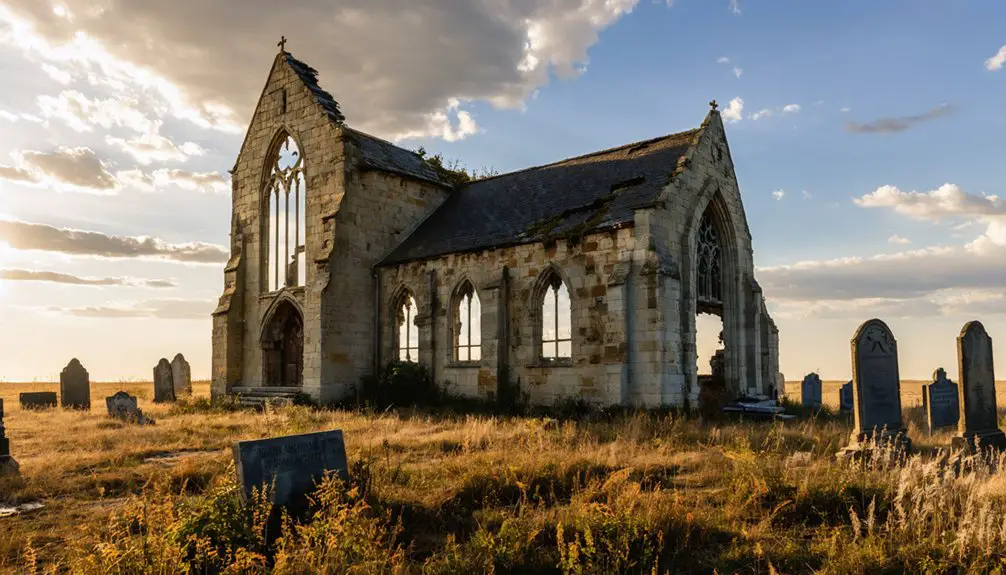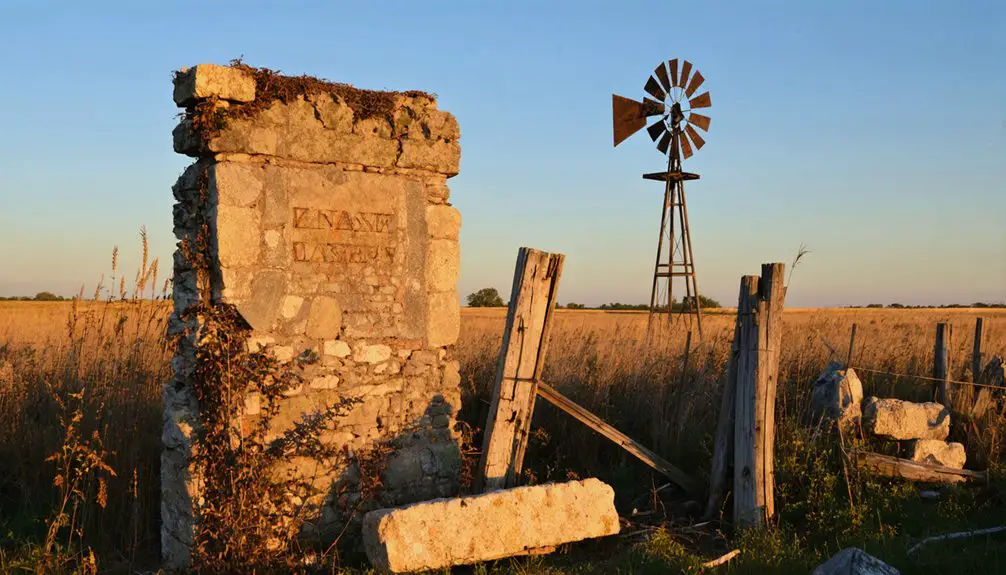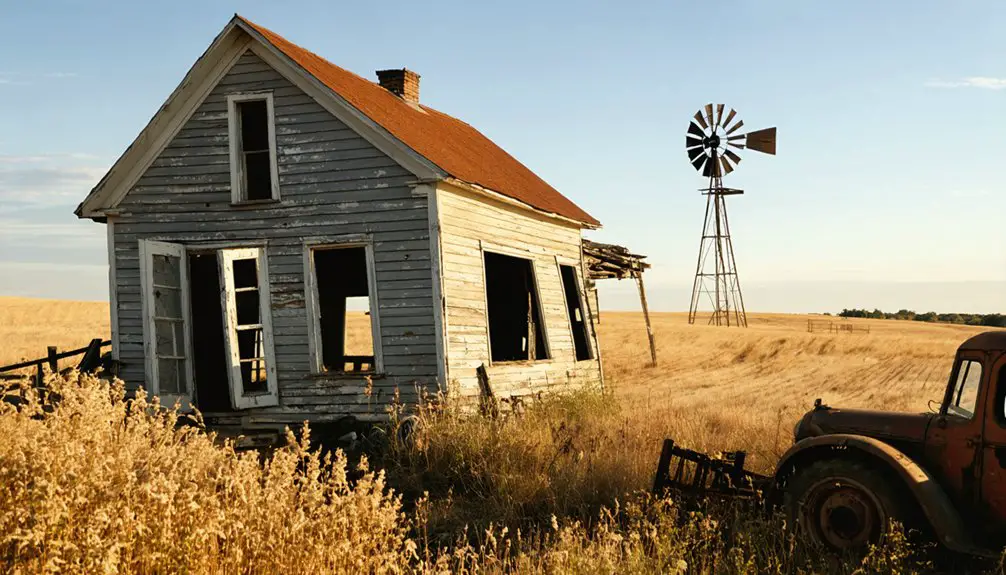You’ll find Drury in Sumner County, Kansas, where Alexander Culbertson’s 1883 mill sparked a vibrant community along the Chikaskia River. By 1910, this railroad hub peaked with 28 residents and transformed into the “Playground of Kansas & Oklahoma,” featuring a grand hotel, movies on floating screens, and riverside recreation. Though the post office closed in 1921, marking its decline, you can still discover remnants of Drury’s prosperous past amid its quiet streets.
Key Takeaways
- Drury thrived as a tourist destination in the 1910s-1920s, known as the “Playground of Kansas & Oklahoma” before declining into a ghost town.
- The town’s population peaked at 28 residents in 1910 and has dwindled to approximately 10 residents in modern times.
- Key structures included a stone mill, three-story hotel, grain elevator, and several commercial buildings, now mostly abandoned or deteriorating.
- The closure of the post office in 1921 marked the beginning of Drury’s decline from a bustling railway and river transport hub.
- The ghost town gained renewed attention after being featured in the 1981 film “Americana,” showcasing its abandoned buildings and historic charm.
Early Beginnings and Mill Heritage
When Alexander Culbertson constructed the Drury dam and mill in 1883, he established what would become an essential economic center along the Chikaskia River in Kansas. He named the settlement after his wife and built the mill on a natural rock shelf, creating a 3-foot waterfall to power the operation.
The mill operations featured 2,300-pound French grinding burrs, processing wheat, corn, and rye into flour for the region. Today, only the stone shell of this historic mill remains standing.
Community growth followed swiftly, and by 1887, you’d have found a proper post office serving the area. The mill’s success spurred the development of additional businesses, including a grocery store, hotel, and broom factory. In 1916, the mill was converted to a power plant facility to provide electricity for the growing town.
The bustling settlement of Drury quickly expanded beyond its mill origins, adding vital services like a post office and various merchant shops.
At its peak in the early 1900s, Drury’s population reached 28 residents, marking it as a small but crucial trade center.
The Railroad’s Influence
After Drury established its milling operations, the arrival of the Kansas Southwestern Railway in 1887 transformed the settlement into an essential transportation hub.
The railroad expansion positioned Drury strategically between South Haven and Caldwell, revolutionizing local transportation economics. You’d have found steam locomotives hauling wheat, corn, and flour from the town’s mill, while the station’s placement near the Chikaskia River created an efficient multi-modal transport system. Like many locations sharing the name Drury, this Kansas town needed clear disambiguation efforts to distinguish it from other similarly named places. Much like the Atchison & Nebraska Railroad that reached Doniphan in 1871, the railway connection brought new growth and commerce to the area.
The railway’s impact extended beyond commerce, turning Drury into a vibrant tourist destination. You could’ve arrived by train to enjoy riverfront activities, stay at the local hotel, or visit the “Merry-Go-Round” beer joint.
This golden age wouldn’t last forever, though. When rail service eventually discontinued, Drury’s significance faded, leading to the closure of its post office in 1921 and its ultimate descent into ghost town status.
Peak Economic Development
Prosperity defined Drury’s peak economic period from 1887 through 1910, anchored by its French-imported millstones and strategic position along the Kansas Southwestern Railway. Like many grain shipping centers in Kansas, Drury benefited from the agricultural boom of the era.
You’d find economic diversification throughout the town’s operations, from its state-of-the-art flour mill processing wheat, corn, and rye to its specialized broom corn factory. The mill’s 2,300-pound French burrs showcased the town’s commitment to agricultural innovation. Similar to Bell Plane’s orchards, local agriculture drove the economy forward.
Despite its modest population of 28 residents, Drury’s commercial significance supported multiple businesses, including a grocery store, hotel, and money order post office.
The town’s position as a crucial shipping point meant you could transport goods efficiently by rail, while the Chikaskia River provided additional trade opportunities, cementing Drury’s role as a dynamic agricultural hub.
Tourism and Entertainment Era
During the 1910s and 1920s, Drury transformed from a milling center into the “Playground of Kansas & Oklahoma,” drawing weekend tourists from Wichita, Caldwell, and surrounding towns.
You’d find numerous tourist amenities centered around the Chikaskia River’s natural rock shelf and 3-foot waterfall, with the impressive 46-room Drury Hotel anchoring the bustling resort scene. The hotel’s legacy lives on through ghostly encounters reported by former guests who stayed there.
The town offered an array of recreational activities that you wouldn’t want to miss:
- Movies projected onto a floating river screen under the stars
- Dancing at the pavilion with live entertainment
- Boating, swimming, and fishing at the scenic riverfront
- Drinks and socializing at the popular “Merry-Go-Round” beer joint
Regular bus and rail service made it easy to reach Drury’s attractions, while the Meridian Road connected visitors from both Kansas and Oklahoma. Day and night bus service from Caldwell ensured visitors could come and go at their convenience.
Community Life and Population Changes
While Drury’s establishment in 1882 marked the beginning of a promising community, its population never grew beyond a small rural settlement, peaking at just 28 residents in 1910.
You’d have found a tight-knit social fabric woven through the local church, schoolhouse, and community gatherings at the three-story hotel’s dance pavilion and beer joint.
The town’s liveliness hinged on essential services like the post office, grocery store, and railway station. To avoid confusion with other locations, historical records often referred to it as Sumner County’s Drury.
However, social decline became inevitable as these amenities disappeared one by one. The post office’s closure in 1921 dealt a significant blow, followed by the railway’s abandonment.
The town’s heartbeat faded as vital services vanished, starting with the post office in 1921, soon followed by the lifeline railway.
Today, you’ll find only about 10 residents in what’s become a ghost town, with just the old schoolhouse and playground equipment standing as silent witnesses to Drury’s more vibrant past.
Natural Features and Geography
You’ll find Drury’s heart centered on the Chikaskia River, where a natural flat rock shelf provided the perfect foundation for an 1883 mill dam.
The dam’s modest 3-foot waterfall remains a symbol of the town’s strategic use of its natural resources, as French burr millstones once ground wheat, corn, and rye at this location.
The river valley’s gentle terrain, typical of Sumner County’s prairie landscape, created an ideal setting for the mill operations and early settlement, with the waterway serving both industrial and recreational purposes. Like many historic sites in the region, rainy weather often casts a somber atmosphere over the abandoned structures and remnants of this once-thriving community.
Chikaskia River Setting
Along the fertile plains of southern Kansas, the Chikaskia River stretches 159 miles from its source in southwest Pratt County to its confluence with the Salt Fork of the Arkansas River near Tonkawa, Oklahoma.
You’ll find this dynamic waterway carving through the Great Plains, dropping from 925 feet to 282 feet in elevation as it shapes the natural habitat of the region.
The Chikaskia’s terrain features:
- Gently rolling uplands with dissected plains
- Alluvial valleys and terrace deposits
- Sand dune formations in southwestern areas
- Variable soil permeability affecting water flow
The river’s course parallels the South Fork of the Ninnescah River, draining the southern half of Kingman County.
With its tributaries like Sand Creek and Spring Creek, the Chikaskia creates a diverse ecosystem across the High Plains and Red Hills physiographic divisions.
Geological Rock Foundation
The geological foundation of Drury rests upon the characteristic limestone and sandstone formations of the Great Plains, creating an ideal setting for early settlement and development.
You’ll find naturally occurring rock shelves along the Chikaskia River, which proved instrumental in the construction of the Drury Mill dam in 1883. The area’s geological stability minimized risks from earthquakes and landslides, making it perfect for building permanent structures.
The fertile soil composition, typical of this region, supported robust agricultural activities.
The limestone formations provided a solid base for infrastructure while contributing to effective water management. You can still see evidence of how settlers maximized these natural advantages, from the strategic placement of the mill to the cultivation of farmland that sustained the community during its prime years.
Notable Historical Structures

While many ghost towns retain few physical remnants of their past, Drury’s landscape remains dotted with significant historical structures that paint a vivid picture of its heyday.
Unlike most abandoned towns, Drury’s well-preserved buildings stand as silent witnesses to its prosperous past.
The town’s architectural significance reflects its economic legacy through several key buildings you’ll still find standing today:
- The 1883 stone mill with its imported French burrs sits proudly on the natural rock shelf, alongside a 3-foot waterfall in the Chikaskia River.
- A three-story hotel complex that once boasted 46 rooms, complete with guest cabins and entertainment venues including a unique river-raft movie projection setup.
- The tin grain elevator stands as a symbol of the area’s agricultural heritage.
- Several commercial buildings line the main street, including the community church, school, and former broom factory.
Cultural Impact and Film History
You’ll find Drury’s cultural legacy most prominently displayed in the 1981 film *Americana*, which used the ghost town‘s atmospheric ruins and natural scenery as its backdrop.
During its heyday in the early 1900s, Drury earned its reputation as the “Playground of Kansas & Oklahoma,” offering visitors entertainment at venues like the three-story hotel, dance pavilion, and the popular “Merry-Go-Round” beer joint.
The town’s transformation from bustling recreation hub to cinematic setting mirrors countless Midwestern communities whose stories of boom-and-bust now captivate filmmakers and historians alike.
Americana Movie Heritage
During 1981, independent filmmakers descended upon Drury, Kansas, to shoot *Americana*, a drama that would immortalize this ghost town’s rustic charm and historical significance.
The film’s themes of Americana nostalgia and ghost town preservation perfectly mirrored Drury’s own journey from thriving mill town to abandoned settlement.
- The movie gained cult status among indie film enthusiasts and became a touchstone for rural narratives.
- Drury’s authentic locations, including the dam and mill sites, symbolized pioneering American industry.
- Film tourism brought modest but steady interest from fans exploring the shooting locations.
- The production stimulated documentation efforts around Drury’s historical landmarks.
You’ll find that Americana continues to serve as a crucial link between Drury’s past and present, preserving its legacy in American cinematic history while encouraging heritage tourism throughout Sumner County.
Golden Age Entertainment Hub
Beyond its later cinematic fame, Drury earned its first cultural spotlight as the “playground of Oklahoma and Kansas” in the early 20th century.
You’d find a vibrant hub of leisure activities centered around a hotel, dancing pavilion, and bathhouse where visitors from neighboring states gathered for weekend getaways.
The dancing pavilion became the heart of Drury’s social scene, hosting live music and social gatherings that brought together rural and small-town residents from both Kansas and Oklahoma.
You could experience the mixing of different backgrounds and traditions, as the resort’s welcoming atmosphere encouraged diverse social interaction.
This cultural fusion helped create a distinct regional identity that celebrated local customs while fostering a spirit of hospitality, making Drury a symbol of early 20th-century American leisure culture.
Present-Day Remnants

The remnants of Drury, Kansas tell a compelling story of its past prosperity through various surviving structures.
You’ll find vacant buildings along main street that once housed bustling shops and businesses, their late 19th-century facades standing as silent witnesses to the town’s former liveliness.
- The old schoolhouse and its weathered playground equipment remain as indicators of a thriving community life.
- A tin grain elevator and the stone shell of the original flour mill showcase the town’s agricultural heritage.
- The historic 3-foot waterfall on the Chikaskia River features the mill’s foundation and recreational remnants.
- Scattered houses and an old motel near the river reflect Drury’s evolution from resort destination to ghost town.
These architectural survivors paint a vivid picture of a once-flourishing Kansas settlement.
Frequently Asked Questions
What Happened to the Original French Millstones After the Mill Closed?
You won’t find clear records of the millstones’ fate due to gaps in historical documentation, though their preservation remains uncertain. Their historical significance suggests they may have been abandoned, repurposed, or removed.
Were Any Famous People Known to Have Stayed at Drury Hotel?
While grand hotels across Kansas hosted celebrities and gangsters, there’s no documented evidence of famous guests staying at any Drury hotel – though you’ll find rich cultural history in its walls.
How Did Locals Handle Medical Emergencies Without a Resident Doctor?
You’d rely on first aid from experienced neighbors, traditional emergency remedies, and community support while waiting for traveling doctors. Mutual aid networks helped coordinate care and summon medical help from nearby settlements.
What Native American Tribes Inhabited the Area Before Drury’s Establishment?
With around 1,500 members in the early 1800s, the Kansa (Kaw) were your region’s primary inhabitants, while Osage, Pawnee, and later-relocated Shawnee tribes shared hunting grounds and cultural impact.
Did Any Significant Crimes or Incidents Occur During Drury’s Peak Years?
You won’t find records of major crime incidents during Drury’s peak years. Despite the town’s recreational nature with beer joints and gatherings, there’s no evidence of significant law enforcement challenges.
References
- https://legendsofkansas.com/drury-kansas/
- https://www.ghosttowns.com/states/ks/drury.html
- https://www.legendsofamerica.com/doniphan-kansas/
- https://en.wikipedia.org/wiki/Drury
- https://www.travelks.com/blog/stories/post/13-most-haunted-places-in-kansas-you-must-visit-this-fall/
- https://www.sumnernewscow.com/drury-playground-of-kansas-and-oklahoma/
- https://gateway.okhistory.org/ark:/67531/metadc2110053/
- https://freepages.rootsweb.com/~gtusa/history/usa/ks.htm
- https://www.sumnernewscow.com/history-of-drury-presentation-was-well-attending/
- https://www.youtube.com/watch?v=OyBXD18P_j4



